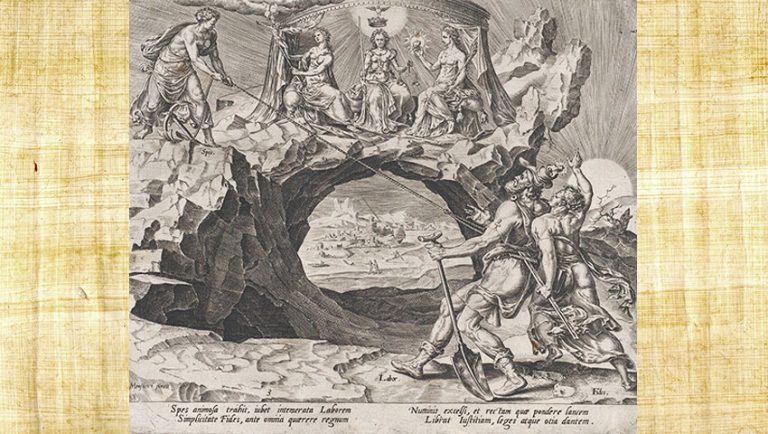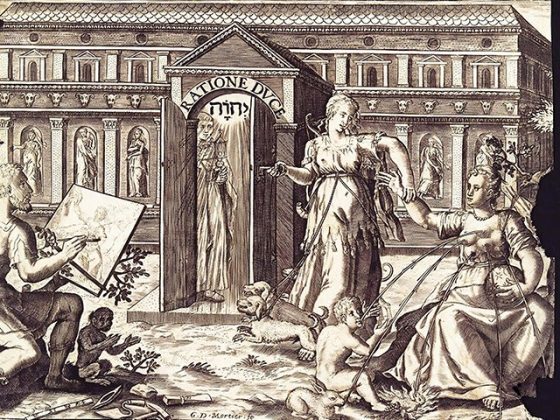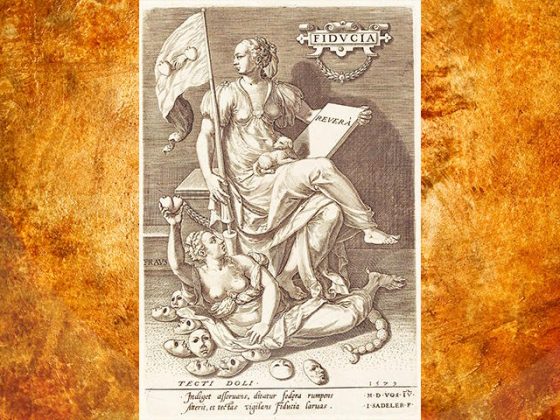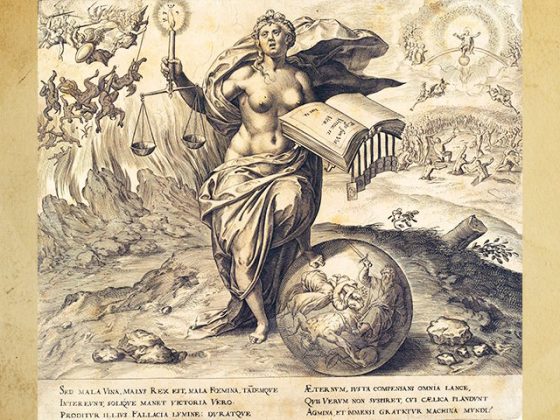Dearest readers:
On this occasion, I would like to send you an engraving that deserves to be explained and which is entitled…
…THE DILIGENT WORKER
This series was printed by Philip Galle (1537-1612), one of the most important printers and engravers in the Netherlands and throughout Europe, known for his engravings on copper plates. The concept and drawing belong to Maarten van Heemskerck (1498-1574), a Dutch portraitist and painter of religious subjects famous for the numerous drawings he provided for engraving. This engraving is the third plate in a series called The Reward of Work and Diligence.
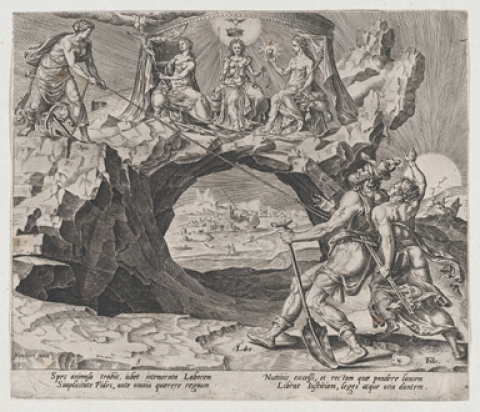
Maarten van Heemskerck, (1498-1574)
To go into details, we will begin by describing a large rock that has an opening in its structure to allow passers-by or travelers who want to make the journey to the Father who is in secret to pass.
Such a rock allegorizes the mysteries of the superior sexuality. The travellers who appear in the engraving are, interestingly, a man and a woman, the man carrying a shovel and the woman a cross.
The cross, Gnostically, represents the mysteries of the crossing of the lingam-yoni of the science of Tantra. The man wears a kind of lamp on his head, indicating that he carries light to travel along the Secret Path. On the other hand, the man’s shovel ends at the top in the form of a staff, which associates it with the staff of the Patriarchs. This shovel allegorizes that we must not cease to seek, within ourselves, our inner reality: the BEING, and it reminds us of that alchemist phrase that tells us: Visit interiora terrae rectifying invenies occultum lapidem ─’visit the interior of your philosophical earth which by rectifying you will find the hidden stone’: the Philosopher’s Stone─.
Next to the woman we see the Latin word Fedes, which should be interpreted as ‘FAITH’. Similarly, next to the man we find the word Labor, which we must interpret as “work” upon ourselves.
The couple march very determinedly, both wanting to move forward, in favor of the wind or against all winds. This is because they march full of FAITH and persevering in their alchemical and psychological work.
At the upper part of this engraving, on the majestic rock, we see a man who, with a rope that is tied to the man and the woman, tries to help them by pulling them so that they do not stop. This man represents the Guru that every devotee encounters on his way toward Intimate Self-Realization.
It is good to point out that, with her left arm, the woman grasps or carries a book with her. This is the book of Hermetic science and more clearly the sacred Mercury.
Near the man pulling the couple with the rope is an anchor. This means that the couple’s journey is almost over. Next to this man is a Latin word: spes, which should be translated as ‘hope’…
At the top of the rock we see three ladies sitting and surrounded by a kind of wonderful canopy. Each of these ladies has with her a most sacred relic, let us see:
The lady on the left holds a crucifix with her two arms to indicate the supreme need to incarnate our intimate Christ.
The lady in the center has a great halo on her head, on that halo a crown, and on the crown floats the dove of the Holy Spirit, representative of the third Sephiroth of the Kabbalah: Binah, the Third Logos, the great reconciler, the lord of the great light, the great revealer. This lady holds a sword in her right hand and in her left hand she holds a scale. The sword is the symbol of the Fires raised by the Initiate. It also represents the righteousness and steadfastness of the Adepts. The scale means that anything is possible, spiritually speaking, when we are within the right way of feeling, right way of thinking, and right way of acting.
The third lady holds in one of her hands a heart, a symbol of the Father. Let us remember that in the left ventricle of our heart is the atom nous that connects us to the Father who is in secret. This is to remind us that the supreme love is in the Father and we must always be concentrated on Him. The one who realizes himself or herself is connected to this divine heart.
We could say, generalizing our doctrine, that these three ladies are THE THREE GRACES or THE THREE FORCES of the Creator.
On her left arm, this third lady holds a bouquet of laurels, all of which alludes to the hermetic triumph. Undoubtedly, to approach such “triune” forces means to have dedicated oneself body and soul to the search for our BEING.
On one side of the intrepid couple marching toward the huge rock is a RISING SUN, also a symbol of the triumph in the Great Work.
We cannot overlook the fact that at the top of the canopy we have already mentioned there is a cloud and a hand can be seen emerging from the cloud and pointing to the crucifix held in the arms of the first lady of our description. This hand is that of the supreme THEOMEGALOGOS, who is always ready to receive us after all our voluntary sufferings and conscious sacrifices.
I end this description with the following Latin phrase that appears at the end of our engraving:
«Spes animosa trahit, jubet intemerata Laborem Simplicitate Fides, ante omnia quoaerere regnum Numinis excelsi, et rectam quae pondere lancem Librat Iustitiam, leges atque otia dantem».
Translation:
‘Hope pulls with energy, faith orders with simplicity immaculate works, longing above all for the kingdom of the Supreme God, and the just things that balance the scales of justice, giving laws and liberties’.
I now offer you a few sentences that deserve to be reflected upon:
“Greatness is like perfumes: the one who wears them is the one who perceives them least.”
Christina of Sweden
“Greatness of soul has been, is, and always will be greatness of the first class.”
Chacet
“The truly great ones are the those with a great spirit.”
Quevedo
“Great spirit befits great fortune.”
Seneca
“Greatness is neither taught nor acquired, it is the expression of the spirit of a man privileged by God.”
Ruskin
NULLA DIES SINE LINEA.
─‘No day without a line’─.
Kwen Khan Khu


